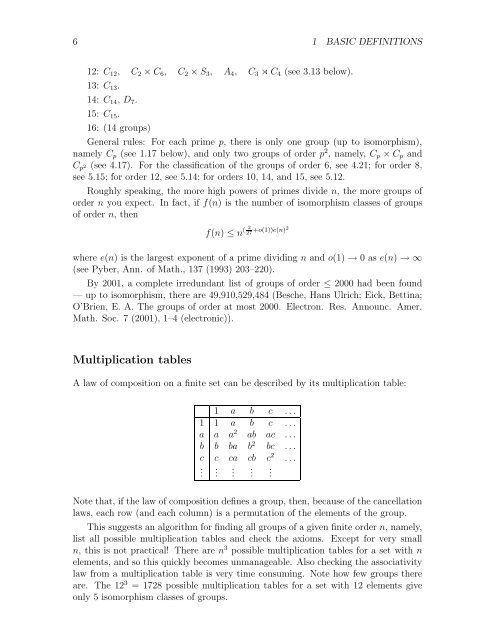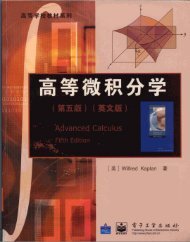Milne - Group Theory.. - Free
Milne - Group Theory.. - Free
Milne - Group Theory.. - Free
You also want an ePaper? Increase the reach of your titles
YUMPU automatically turns print PDFs into web optimized ePapers that Google loves.
6 1 BASIC DEFINITIONS<br />
12: C 12 , C 2 × C 6 , C 2 × S 3 , A 4 , C 3 ⋊ C 4 (see 3.13 below).<br />
13: C 13 .<br />
14: C 14 , D 7 .<br />
15: C 15 .<br />
16: (14 groups)<br />
General rules: For eachprime p, there is only one group (up to isomorphism),<br />
namely C p (see 1.17 below), and only two groups of order p 2 ,namely,C p × C p and<br />
C p 2 (see 4.17). For the classification of the groups of order 6, see 4.21; for order 8,<br />
see 5.15; for order 12, see 5.14; for orders 10, 14, and 15, see 5.12.<br />
Roughly speaking, the more high powers of primes divide n, themoregroupsof<br />
order n youexpect. Infact,iff(n) is the number of isomorphism classes of groups<br />
of order n, then<br />
f(n) ≤ n ( 2<br />
27 +o(1))e(n)2<br />
where e(n) is the largest exponent of a prime dividing n and o(1) → 0ase(n) →∞<br />
(see Pyber, Ann. of Math., 137 (1993) 203–220).<br />
By 2001, a complete irredundant list of groups of order ≤ 2000 had been found<br />
— up to isomorphism, there are 49,910,529,484 (Besche, Hans Ulrich; Eick, Bettina;<br />
O’Brien, E. A. The groups of order at most 2000. Electron. Res. Announc. Amer.<br />
Math. Soc. 7 (2001), 1–4 (electronic)).<br />
Multiplication tables<br />
A law of composition on a finite set can be described by its multiplication table:<br />
1 a b c ...<br />
1 1 a b c ...<br />
a a a 2 ab ac . . .<br />
b b ba b 2 bc ...<br />
c c ca cb c 2 ...<br />
.<br />
.<br />
.<br />
.<br />
.<br />
Note that, if the law of composition defines a group, then, because of the cancellation<br />
laws, eachrow (and eachcolumn) is a permutation of the elements of the group.<br />
This suggests an algorithm for finding all groups of a given finite order n, namely,<br />
list all possible multiplication tables and check the axioms. Except for very small<br />
n, this is not practical! There are n 3 possible multiplication tables for a set with n<br />
elements, and so this quickly becomes unmanageable. Also checking the associativity<br />
law from a multiplication table is very time consuming. Note how few groups there<br />
are. The 12 3 = 1728 possible multiplication tables for a set with12 elements give<br />
only 5 isomorphism classes of groups.

















